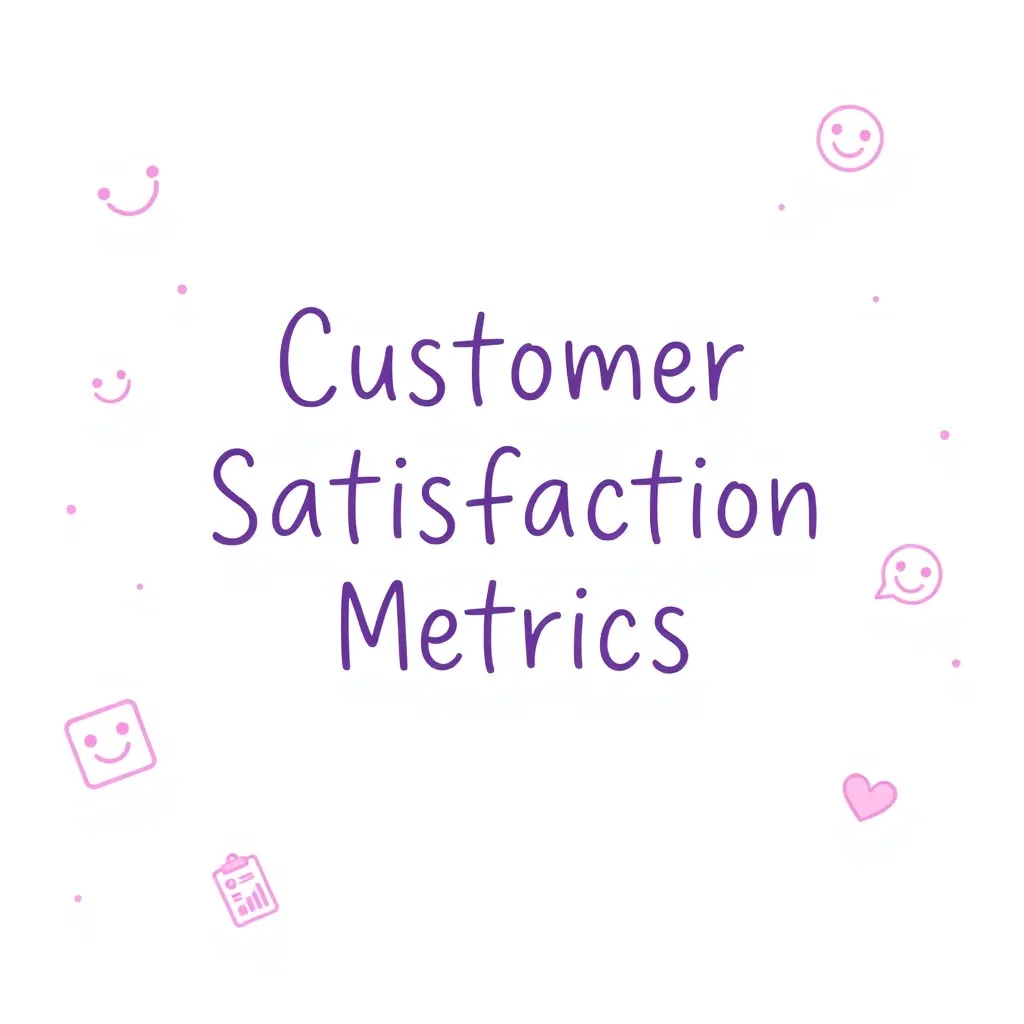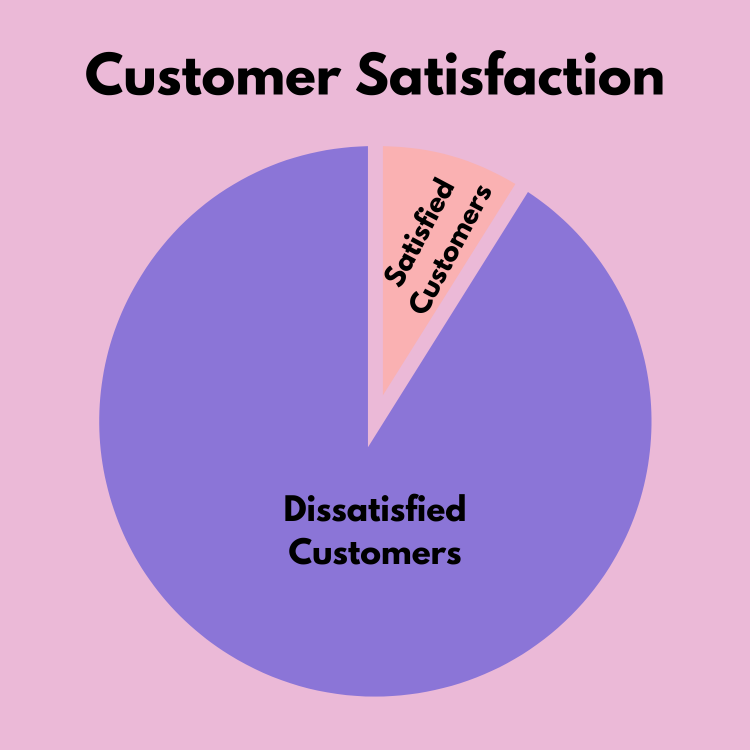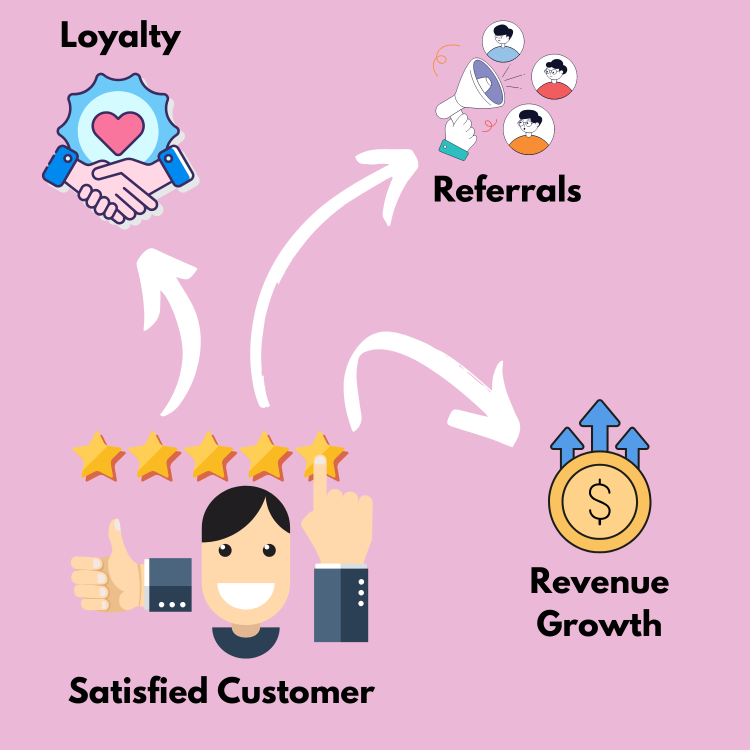The Ultimate Guide to Customer Satisfaction Metrics and Tools [2024]
Master the art of customer satisfaction with essential metrics, tools, and strategies to boost loyalty, improve experiences, and grow your business.
Master the art of customer satisfaction with essential metrics, tools, and strategies to boost loyalty, improve experiences, and grow your business.

In today’s competitive business landscape, customer satisfaction is more than just a buzzword—it’s a critical factor that determines success or failure. Satisfied customers are more likely to remain loyal, recommend your business to others, and contribute to steady revenue growth. On the other hand, dissatisfied customers can quickly turn to competitors, impacting your bottom line and tarnishing your reputation.
But how do you ensure your customers are satisfied? The answer lies in measuring and understanding their experience. Customer satisfaction metrics provide businesses with a structured way to gauge how well they’re meeting customer expectations. From Net Promoter Scores (NPS) that measure loyalty to Customer Effort Scores (CES) that focus on ease of interaction, these metrics offer actionable insights to drive improvements.
Customer loyalty is directly tied to satisfaction, and tracking the right metrics isn’t just about collecting data—it’s about using it to create better customer experiences, build trust, and foster loyalty. In this guide, we’ll dive deep into the most important customer satisfaction metrics, explore the tools that can help you measure them effectively, and provide actionable strategies to optimize your approach. Whether you’re an established brand or a growing business, this guide will equip you with everything you need to enhance your customer satisfaction efforts and grow sustainably.

Customer satisfaction metrics are measurable indicators used to assess how well your business is meeting the needs and expectations of your customers. These metrics serve as a window into your customers’ experiences, highlighting what’s working, what needs improvement, and where potential risks to customer loyalty might lie.
When used correctly, customer satisfaction metrics go beyond surface-level insights. They provide actionable data that informs key decisions across your organization, from refining products and services to improving customer support and retention strategies.

These metrics not only give you a pulse on customer satisfaction but also help you prioritize where to focus your improvement efforts. Each metric provides a unique perspective on customer behavior, and using them in combination offers a well-rounded view of your customer experience.
By the end of this guide, you’ll understand how to choose and implement the right metrics for your business, track performance effectively, and use data to create meaningful improvements that enhance customer satisfaction.

Definition:
CSAT measures how satisfied customers are with a specific interaction, product, or service. It is typically calculated by asking customers to rate their satisfaction on a scale (e.g., 1–5 or 1–10).
Formula:
CSAT = (Positive Responses / Total Responses) × 100
Example Use Case:
After resolving a support ticket, you might ask, “How satisfied were you with the service you received?” Customers rate their experience, and you calculate the percentage of positive ratings.
Why It Matters:
Limitations:
CSAT focuses on short-term satisfaction and doesn’t measure long-term loyalty.
Definition:
NPS measures customer loyalty by asking one key question: “How likely are you to recommend our company/product/service to a friend or colleague?” Customers respond on a scale of 0 to 10.
Calculation:
Why It Matters:
Limitations:
NPS doesn’t explain why customers feel the way they do, so pairing it with follow-up questions is essential.
Definition:
CES measures the ease with which customers can resolve an issue or complete a task, such as making a purchase or getting support.
Survey Question Example:
“How easy was it to get your issue resolved today?” Rated on a scale of “Very Easy” to “Very Difficult.”
Why It Matters:
Limitations:
CES is interaction-specific and doesn’t account for overall satisfaction with the brand.
Definition:
CLV measures the total revenue a business can expect from a customer over their entire relationship. While not exclusively a satisfaction metric, CLV is influenced by how happy customers are with your offerings.
Formula:
CLV = (Average Purchase Value × Purchase Frequency) × Customer Lifespan
Why It Matters:
Limitations:
CLV requires significant data and may not provide real-time insights.
Definition:
Retention rate calculates the percentage of customers who continue to engage with your business over a specific time period.
Formula:
Retention Rate = ((End Customers - New Customers) / Starting Customers) × 100
Why It Matters:
These metrics work together to provide a comprehensive view of customer satisfaction. For example, pairing NPS with CES can reveal both loyalty levels and friction points, helping you address underlying issues more effectively. By implementing these metrics strategically, you can continuously refine your customer experience and build lasting loyalty.
Effectively tracking customer satisfaction requires the right tools to collect, analyze, and act on data. From survey platforms to advanced analytics software, there’s a wide range of tools designed to streamline the process and provide actionable insights. Here’s a breakdown of the most effective tools for measuring customer satisfaction and how they can elevate your strategy.
Customer satisfaction surveys are one of the most direct ways to collect feedback. These tools allow you to design, distribute, and analyze surveys tailored to your needs.
Popular Tools:
Benefits:
Use Case:
Send a post-purchase survey via email asking customers to rate their shopping experience. Use the responses to calculate your CSAT score.
These platforms collect and analyze customer feedback from multiple sources, such as reviews, social media, and online forums.
Popular Tools:
Benefits:
Use Case:
Track reviews on Trustpilot to monitor brand perception and identify recurring customer pain points.
CRM platforms integrate customer satisfaction data into your broader business operations, automating follow-ups and centralizing customer insights.
Popular Tools:
Benefits:
Use Case:
Use HubSpot to send NPS surveys and trigger automated emails to detractors, addressing their concerns quickly.
Advanced analytics platforms help you dive deeper into customer satisfaction data to identify patterns and trends.
Popular Tools:
Benefits:
Use Case:
Use Tableau to create a dashboard combining NPS, CSAT, and CES data, allowing you to track customer satisfaction across touchpoints.
For businesses operating across multiple platforms, centralized tools simplify tracking satisfaction across channels. Managing multiple e-commerce channels effectively is crucial for maintaining consistent customer satisfaction.
Popular Tools:
Benefits:
Use Case:
Leverage OneCart to identify customer satisfaction trends tied to order fulfillment accuracy and shipping times.
Selecting the right customer satisfaction metrics and tools isn’t a one-size-fits-all process. The best combination depends on your business model, industry, customer base, and specific goals. This section will guide you through the factors to consider when choosing metrics and tools to track customer satisfaction effectively.
Start by identifying your key business objectives and match them with the appropriate metrics. Different metrics provide insights into different aspects of your customer experience.
Pro Tip: Prioritize a combination of metrics to capture a well-rounded view of customer satisfaction.
Customer satisfaction priorities vary across industries, so it’s essential to tailor your approach to your sector.
The scale of your business affects the tools and metrics you’ll need.
Pro Tip: As your business grows, ensure your tools and processes can scale to meet increasing demands.
Customers expect fast responses to their concerns. Tools with real-time analytics and automation features ensure you can act on feedback promptly.
Seamless integration with your current tech stack is essential for efficiency.
While free tools like Google Forms work well for small businesses, larger organizations may benefit from investing in robust platforms like Qualtrics or HubSpot. Evaluate the ROI of each tool based on its ability to provide actionable insights that drive satisfaction and loyalty.
By answering these questions and aligning your tools and metrics with your goals, you can create a tailored strategy for tracking and improving customer satisfaction. This clarity ensures your efforts are focused on driving real value for your business and customers.
In the next section, we’ll cover best practices for monitoring and improving customer satisfaction to help you get the most out of your chosen metrics and tools.
Effectively monitoring customer satisfaction is only part of the equation. The real value comes from using insights to create meaningful improvements that enhance the customer experience. Implementing these best practices will help you maximize the impact of your satisfaction metrics and tools.
Customer expectations and behaviors change over time, so it’s essential to keep your feedback process dynamic.
Pro Tip: Combine qualitative feedback (e.g., open-ended questions) with quantitative metrics for a comprehensive understanding of customer sentiment.
Collecting feedback is only valuable if you act on it. Use automation and workflow integrations to ensure prompt responses.
Example: A customer reports difficulty navigating your website. Address the issue by simplifying the user interface and notifying the customer of the improvement.
Your frontline teams play a critical role in influencing customer satisfaction. Equip them with the tools and training to deliver exceptional experiences.
Pro Tip: Share positive feedback with your team to reinforce behaviors that lead to high satisfaction scores.
Not all customers are the same. Segment your audience based on demographics, buying behavior, or satisfaction levels to provide targeted improvements.
Example: If NPS surveys reveal that long-term customers value personalized follow-ups, implement a loyalty program with tailored communication.
Regularly review satisfaction metrics to spot trends and compare them against industry benchmarks.
Pro Tip: Benchmark your metrics to competitors in your niche to understand where your business stands in the marketplace.
Use customer satisfaction data to guide your decision-making and prioritize changes that directly impact the customer experience.
Example: A high CES score indicates that customers find your return process difficult. Simplify it by offering pre-filled return forms and free shipping.
Transparency builds trust and loyalty. Let customers know how their feedback has driven improvements.
Pro Tip: Highlight improvements in your NPS or CSAT scores to demonstrate progress and reinforce trust.
Even with the right metrics and tools, businesses often encounter challenges that hinder their ability to measure and improve customer satisfaction effectively. Avoiding these common pitfalls can save time, money, and customer trust while ensuring your efforts drive meaningful results.
The Problem:
Focusing solely on one metric, such as NPS or CSAT, can give a skewed or incomplete picture of customer satisfaction.
How to Avoid:
Example: Pair NPS with CES to uncover not just loyalty levels but also the friction points in the customer experience.
The Problem:
It’s easy to celebrate positive feedback and dismiss complaints as isolated incidents, but doing so prevents you from addressing root causes of dissatisfaction.
How to Avoid:
Example: If multiple customers complain about long response times in CES surveys, investigate your support process and allocate more resources to reduce wait times.
The Problem:
Collecting feedback without informing customers of the actions taken can make them feel unheard, reducing future survey participation.
How to Avoid:
Example: Share a “You Spoke, We Listened” campaign showcasing updates to your return policy based on customer feedback.
The Problem:
Failing to share your goals or progress with customers can make them feel disconnected from your efforts to improve.
How to Avoid:
Example: Publish a quarterly customer satisfaction report that highlights improvements and outlines upcoming initiatives.
Customer satisfaction metrics are measurable indicators used to evaluate how well your business meets customer expectations. Common examples include Customer Satisfaction Score (CSAT), Net Promoter Score (NPS), and Customer Effort Score (CES). These metrics provide insights into customer experiences, loyalty, and pain points.
Customer satisfaction metrics help businesses:
The best metric depends on your business goals:
Popular tools include:
Customer satisfaction drives business growth. Metrics like CSAT, NPS, and CES provide actionable insights to improve experiences and loyalty. Tools like CRMs and survey platforms help track trends and guide improvements. Act on feedback promptly, avoid common pitfalls, and use a mix of metrics for a complete view. By prioritizing customer satisfaction, businesses can enhance loyalty, reduce churn, and gain a competitive edge.
Delight your customers with better insights. Try OneCart to integrate satisfaction tracking with inventory and order management.
Automate & Scale Your Online Business with OneCart
Start a Free TrialUsed by hundreds of merchants in Singapore & Southeast Asia